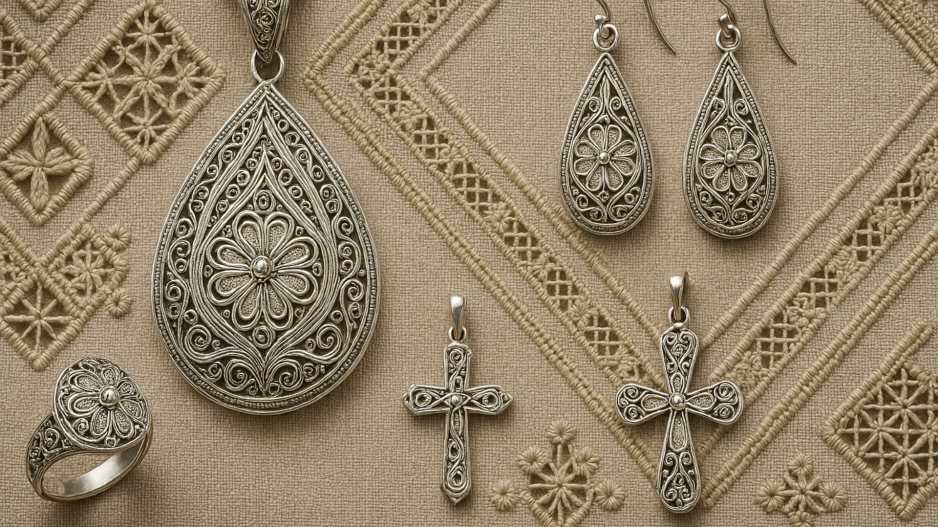How Cypriot Jewelry Designers Are Reviving Ancient Craftsmanship
Tradition Meets Innovation In The Hands Of Cyprus’ Jewelry Makers
Cyprus has long been a crossroads of civilizations, each leaving an indelible mark on its cultural and artistic heritage. Among the most enduring legacies is its jewelry craftsmanship—a testament to the island's rich tapestry of influences and its artisans' unparalleled skill. In recent years, a renaissance has emerged, with contemporary Cypriot jewelry designers delving deep into their heritage to revive and reinterpret ancient techniques, ensuring that the island's storied past continues to shine in the modern era.
The tradition of jewelry making in Cyprus is as ancient as the island's history itself. Archaeological discoveries reveal that as early as 2500 B.C., Cypriot artisans were crafting gold and silver jewelry, drawing influences from neighboring civilizations such as the Near East and the Aegean region. During the Late Bronze Age (circa 1600–1050 B.C.), Cyprus became a significant hub for copper production and export, further enriching its metallurgical and artistic practices.
The island's strategic position fostered extensive trade, leading to a confluence of styles and techniques. For instance, the Cypro-Archaic period (circa 750–480 B.C.) saw the assimilation of Assyrian, Egyptian, and Greek artistic elements, resulting in unique jewelry pieces adorned with intricate motifs and sophisticated metalwork. Techniques such as filigree—delicate metalwork involving twisted threads—became hallmarks of Cypriot jewelry, reflecting a blend of indigenous creativity and external influences.
Cypriot jewelry has been profoundly shaped by various cultural elements that have left an indelible mark on its design and craftsmanship. These influences have infused Cypriot jewelry with unique characteristics, blending traditional motifs with contemporary aesthetics.
-
Byzantine Art: The island's Byzantine heritage introduced religious iconography and intricate designs into jewelry pieces. Crosses, saints, and other ecclesiastical symbols became prevalent, often adorned with enameling techniques that added vibrant colors to gold and silver pieces.
-
Ancient Pottery and Terracotta Figurines: The motifs and patterns found on ancient Cypriot pottery and terracotta figurines have inspired jewelry designs. Geometric patterns, stylized human forms, and depictions of flora and fauna from these artifacts have been reimagined in metal and gemstones, bridging the gap between functional art and personal adornment.
-
Lefkara Lace: The village of Lefkara is renowned for its exquisite lace-making tradition known as "Lefkaritika." Dating back to at least the 14th century, this intricate embroidery art has been influenced by indigenous crafts, Venetian embroidery from the period of Venetian rule beginning in 1489, and ancient Greek and Byzantine geometric patterns. Lefkara lace is characterized by its hemstitch, cut work, satin stitch fillings, and needlepoint edgings. This meticulous craftsmanship has not only been preserved in textiles but has also inspired jewelry designs, with artisans incorporating lace-like patterns into metalwork, creating pieces that echo the delicate intricacy of Lefkara lace.
In the contemporary landscape, Cypriot jewelry designers are passionately reviving these ancient crafts, infusing them with modern aesthetics that meet the needs and trends of today, while retaining ancient aesthetics and odes to the island and the Mediterranean.
Designers like Maria Chara are also at the forefront of this revival. Her brand, Maria Chara Jewelry, skillfully weaves the rich tapestry of art history into contemporary designs. Each piece pays homage to the cultural legacies of Cyprus and ancient Greece, seamlessly infusing them with a modern twist that resonates with today's dynamic fashion landscape. What sets Maria Chara Jewelry apart is an unwavering dedication to craftsmanship, paired with a fervent commitment to nurturing a community of empowerment. Every jewelry piece is meticulously handcrafted, brought to life through the collaborative efforts of a team of exceptionally talented women artisans.
Politia Jewelry, established in 1967, is a family-run business renowned for its unique gemstone jewelry and bespoke designs. Handcrafted in Cyprus and shipped worldwide, their collections feature one-of-a-kind pieces that blend luxury with personal craftsmanship. Politia's signature style incorporates colorful gemstones such as emeralds and sapphires, inspired by the island's natural beauty. Each meticulously crafted design reflects the passion and dedication of highly skilled artisans, making it a symbol of exquisite quality and unparalleled style.
Another renowned company, Thalia Kalafatis Jewelry embodies a fusion of traditional Cypriot artistry and contemporary design. Founded by Thalia Kalafatis, a designer deeply rooted in her family's legacy and the traditions of Asia Minor, the brand offers high-quality, affordable jewelry that highlights the wearer's individuality. Utilizing materials such as 9k and 18k gold, sterling silver, and precious and semi-precious stones, each piece is handcrafted by local artisans in Cyprus and Greece. The collections often draw inspiration from Cypriot heritage, with designs that resonate with both historical significance and modern elegance. Thalia's commitment to sustainability is evident in her sourcing of ethical gemstones and emphasis on transparency and traceability, empowering customers to make responsible choices.
Actina Jewelry offers modern heirloom pieces inspired by Mediterranean life. Handcrafted from ethical silver and gold, their designs reflect a commitment to sustainability and timeless elegance. Actina's creations are characterized by clean lines and organic forms, capturing the essence of the Mediterranean's natural beauty. Their dedication to eco-friendly practices is evident in their use of plastic-free packaging, aligning with a broader movement towards responsible luxury.
These designers, among others, are not merely preserving traditional methods but are reimagining them, ensuring that Cypriot jewelry remains both a nod to the past and a statement of contemporary artistry.
The resurgence of ancient craftsmanship in Cypriot jewelry is a testament to the island's enduring cultural heritage. Through the dedication of contemporary designers, traditional techniques are not only being preserved but also celebrated and reinvented for future generations.






